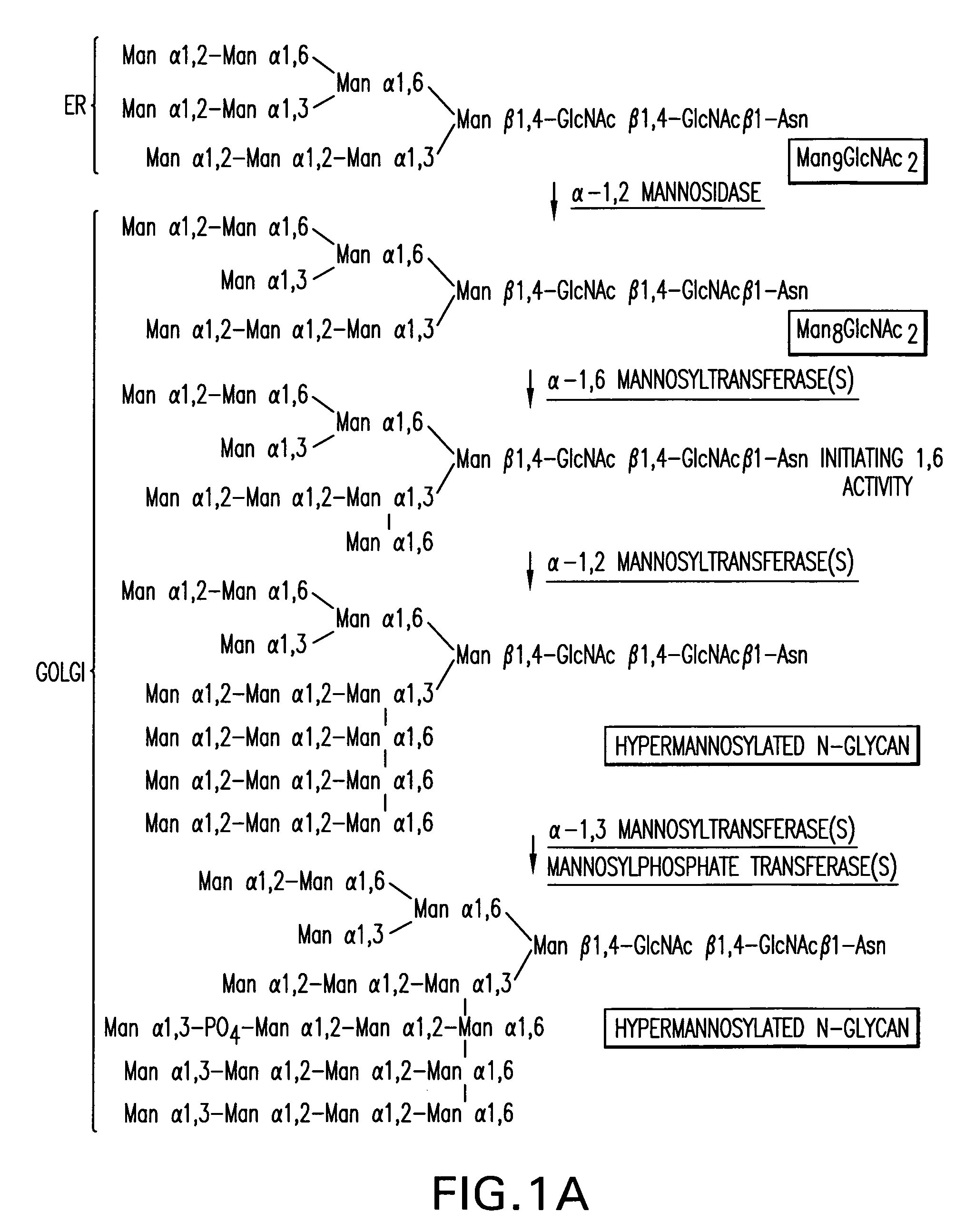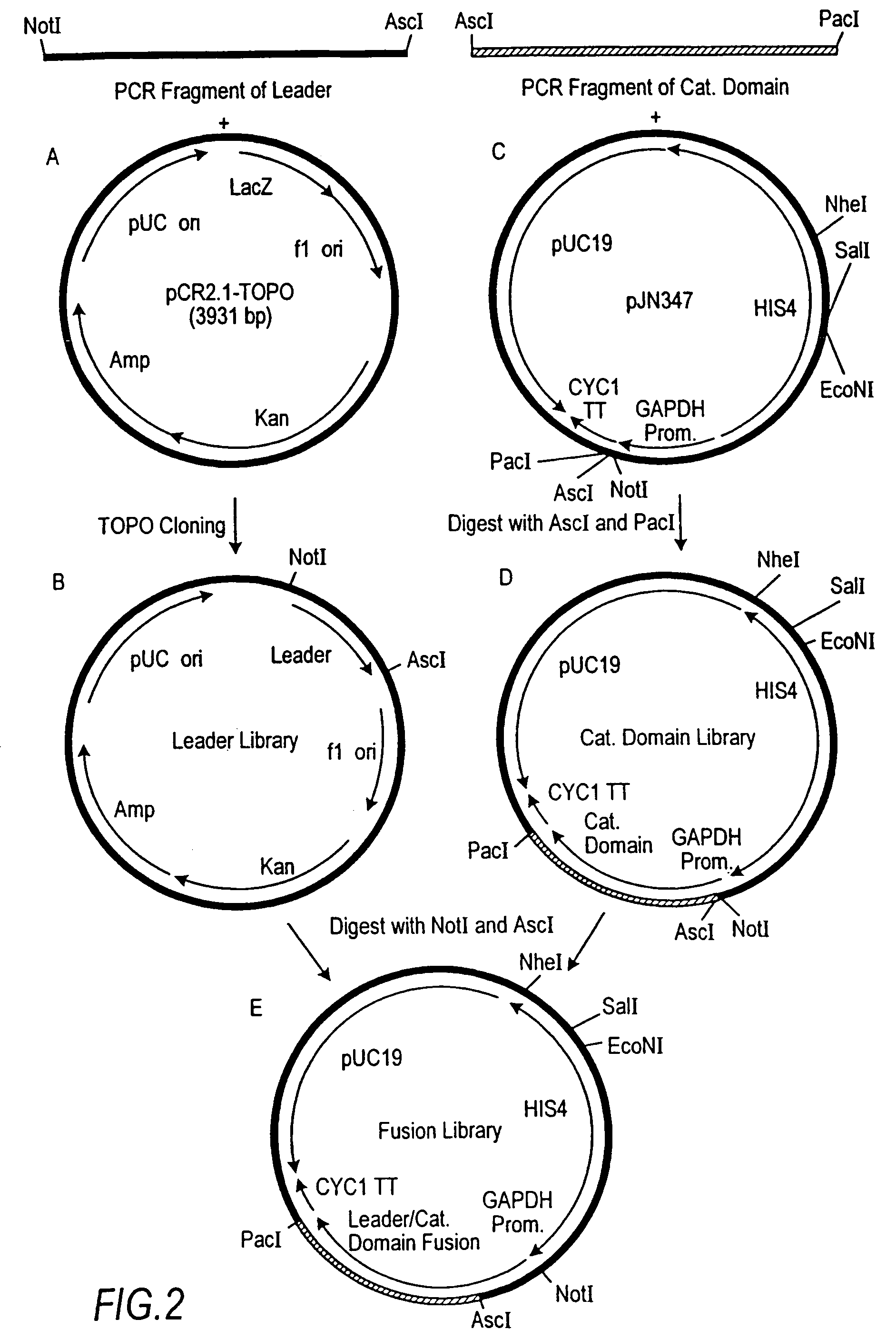Expression of class 2 mannosidase and class III mannosidase in lower eukaryotic cells
- Summary
- Abstract
- Description
- Claims
- Application Information
AI Technical Summary
Benefits of technology
Problems solved by technology
Method used
Image
Examples
example 1
Cloning and Disruption of the OCH1 Gene in P. pastoris
[0661]A 1215 bp ORF of the P. pastoris OCH1 gene encoding a putative α-1,6 mannosyltransferase was amplified from P. pastoris genomic DNA (strain X-33, Invitrogen, Carlsbad, Calif.) using the oligonucleotides 5′-ATGGCGAAGGCAGATGGCAGT-3′ (SEQ ID NO: 18) and 5′-TTAGTCCTTCCAACTTCCTTC-3′ (SEQ ID NO: 19) which were designed based on the P. pastoris OCH1 sequence (Japanese Patent Application Publication No. 8-336387). Subsequently, 2685 bp upstream and 1175 bp downstream of the ORF of the OCH1 gene were amplified from a P. pastoris genomic DNA library (Boehm, T. et al. Yeast 1999 May; 15(7):563-72) using the internal oligonucleotides 5′-ACTGCCATCTGCCTTCGCCAT-3′ (SEQ ID NO: 20) in the OCH1 gene, and 5′-GTAATACGACTCACTATAGGGC-3′ T7 (SEQ ID NO: 21) and 5′-AATTAACCCTCACTAAAGGG-3′ T3 (SEQ ID NO: 22) oligonucleotides in the backbone of the library bearing plasmid lambda ZAP II (Stratagene, La Jolla, Calif.). The resulting 5075 bp fragment w...
example 2
Engineering of P. pastoris with α-1,2-Mannosidase to Produce Man5GlcNAc2-Containing IFN-β Precursors
[0664]An α-1,2-mannosidase is required for the trimming of Man8GlcNAc2 to yield Man5GlcNAc2, an essential intermediate for complex N-glycan formation. While the production of a Man5GlcNAc2 precursor is essential, it is not necessarily sufficient for the production of hybrid and complex glycans because the specific isomer of Man5GlcNAc2 may or may not be a substrate for GnTI. An och1 mutant of P. pastoris is engineered to express secreted human interferon-β under the control of an aox promoter. A DNA library is constructed by the in-frame ligation of the catalytic domain of human mannosidase IB (an α-1,2-mannosidase) with a sub-library including sequences encoding early Golgi and ER localization peptides. The DNA library is then transformed into the host organism, resulting in a genetically mixed population wherein individual transformants each express interferon-β as well as a synthet...
example 3
Generation of an och1 Mutant Strain Expressing an α-1,2-Mannosidase, GnTI for Production of a Human-Like Glycoprotein
[0666]The 1215 bp open reading frame of the P. pastoris OCH1 gene as well as 2685 bp upstream and 1175 bp downstream was amplified by PCR (see also WO 02 / 00879), cloned into the pCR2.1-TOPO vector (Invitrogen) and designated pBK9. To create an och1 knockout strain containing multiple, auxotrophic markers, 100 μg of pJN329, a plasmid containing an och1::URA3 mutant allele flanked with SfiI restriction sites was digested with SfiI and used to transform P. pastoris strain JC308 (Cereghino et al. Gene 263 (2001) 159-169) by electroporation. Following incubation on defined medium lacking uracil for 10 days at room temperature, 1000 colonies were picked and re-streaked. URA+ clones that were unable to grow at 37° C., but grew at room temperature, were subjected to colony PCR to test for the correct integration of the och1::URA3 mutant allele. One clone that exhibited the ex...
PUM
| Property | Measurement | Unit |
|---|---|---|
| Fraction | aaaaa | aaaaa |
| Fraction | aaaaa | aaaaa |
| Fraction | aaaaa | aaaaa |
Abstract
Description
Claims
Application Information
 Login to View More
Login to View More - R&D
- Intellectual Property
- Life Sciences
- Materials
- Tech Scout
- Unparalleled Data Quality
- Higher Quality Content
- 60% Fewer Hallucinations
Browse by: Latest US Patents, China's latest patents, Technical Efficacy Thesaurus, Application Domain, Technology Topic, Popular Technical Reports.
© 2025 PatSnap. All rights reserved.Legal|Privacy policy|Modern Slavery Act Transparency Statement|Sitemap|About US| Contact US: help@patsnap.com



